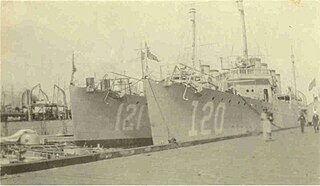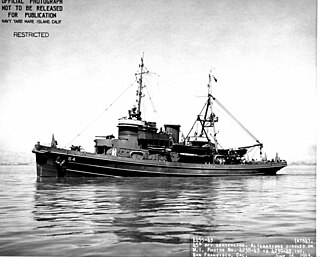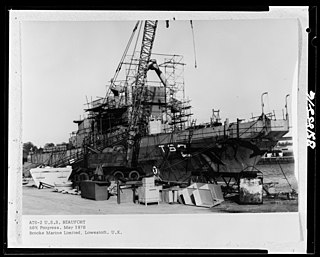
USS Abnaki (ATF-96) was the lead ship of the Abnaki class of fleet ocean tugs in the service of the United States Navy, named after the Abenaki tribe of Native Americans. She was laid down on 28 November 1942 at Charleston, South Carolina by Charleston Shipbuilding & Drydock, launched on 22 April 1943, sponsored by Mrs. James Mayon Jones, and commissioned at the Charleston Navy Yard on 25 November 1943. Abnaki earned three battle stars for service during the Korean War and 10 battle stars during the Vietnam War.

USS Montgomery (DD–121) was a Wickes-class destroyer in the United States Navy during World War I, later reclassified DM-17. She was the fifth ship named Montgomery and was named for Rear Admiral John B. Montgomery.

USS Zuni (AT/ATF-95), a Cherokee-class fleet tugboat, formerly called Navajo class, was a ship of the United States Navy named for the Zuni, the popular name given to a tribe of Pueblo Indians indigenous to the area around the Zuni River in central New Mexico near the Arizona state line.

USS Kanawha (AO–1) was the lead ship of her class of replenishment oilers of the United States Navy. She was commissioned in 1915 and sunk on 8 April 1943 by Japanese aircraft off Tulagi, Solomon Islands.
USS Arikara (AT-98) was an Abnaki-class of fleet ocean tug. It was named after the Arikara, a loose confederacy of sub-tribes of American Indians related to the Pawnee. The Arikara inhabited villages in the Missouri River valley.

USS Navajo (AT-64) was an oceangoing tugboat in the United States Navy, and the lead ship of its class. It was named for the Navajo people. Originally called the Navajo-class of fleet tugs, it was later renamed the Cherokee-class after loss of the first two ships of the class.
USS Navajo (ATR-138/ATA-211) was an auxiliary ocean tug in the United States Navy.
USS Tekesta (AT-93) was Navajo-class fleet tug built during World War II for the United States Navy. Shortly after being built, it was crewed by trained Navy personnel and sent into the Pacific Ocean to provide tug service to damaged ships in battle areas. For successfully performing this dangerous work, she was awarded four battle stars by the war's end.

USS Brackett (DE-41) was an Evarts-class destroyer escort of the United States Navy during World War II. She was sent off into the Pacific Ocean to protect convoys and other ships from Japanese submarines and fighter aircraft. She performed escort and anti-submarine operations in dangerous battle areas and was awarded three battle stars.

USS Chickasaw (AT-83/ATF-83) was a Navajo-class fleet tug constructed for the United States Navy during World War II. She served in the Pacific Ocean in World War II and the Korean War, and was awarded six battle stars for World War II and two battle stars during the Korean War.

USS Lipan (AT-85) was a Navajo-class fleet tug constructed for the United States Navy during World War II. Her purpose was to aid ships, usually by towing, on the high seas or in combat or post-combat areas, plus "other duties as assigned." She served in the Pacific Ocean during World War II and the Korean War. She was awarded two battle stars for World War II and four battle stars for the Korean War.

USS Vireo (AM-52) was a U.S. Navy Lapwing-class minesweeper, No. 52, reclassified on 1 June 1942 as a fleet tug. The bulk of her combat career was served in this capacity.

USS William Ward Burrows was a transport ship that saw service with the United States Navy in World War II. The ship was the former Grace Steamship Company liner MV Santa Rita by Burmeister & Wain and launched in 1929 at Copenhagen, Denmark.
USS Arapaho (AT-68/ATF-68) was a Navajo-class fleet ocean tug which served the U.S. Navy during World War II with her towing services. She was assigned initially to support the U.S. Atlantic Fleet, and was eventually assigned to support Allied forces in the war zones of the Pacific Ocean, resulting in her crew returning home after the war with four battle stars to their credit.

USS Beaufort (ATS-2) was an Edenton-class salvage and rescue ship acquired by the U.S. Navy in 1972 and maintained in service until struck in 1996. Beaufort spent her entire career in the Pacific Ocean, based out of Pearl Harbor and then Sasebo, Japan, and provided salvage and rescue services where needed from the Western Pacific to the North Pacific.

USS Apache (AT-67/ATF-67) was a Navajo-class fleet tug, later fleet ocean tug, in commission in the United States Navy from 1942 to 1946 and from 1951 to 1974. She saw service in World War II, the Korean War, and the Vietnam War.

USNS Navajo (T-ATF-169) was a United States Navy Powhatan-class tugboat operated by the Military Sealift Command which was in service from 1980 to 2016. She spent the bulk of her career in the Pacific and is currently moored in Pearl Harbor, awaiting disposal.
USS Cherokee (AT-66) was a US Navy fleet tug of the Navajo class, later renamed the Cherokee class. She was launched on 10 November 1939 by Bethlehem Shipbuilding Corp., Staten Island, New York and sponsored by Miss E. Mark; and commissioned 26 April 1940. Cherokee served during World War II in the North African campaign. She was redesignated ATF-66 on 15 May 1944.

USS Avoyel (ATF-150) was an Navajo-class fleet tug built for the United States Navy during World War II. She was the only U.S. Naval vessel to bear the name.
USS YP-284 was a converted fishing vessel which served in the U.S. Navy during World War II. She was sunk in action with Japanese destroyers on 25 October 1942.














